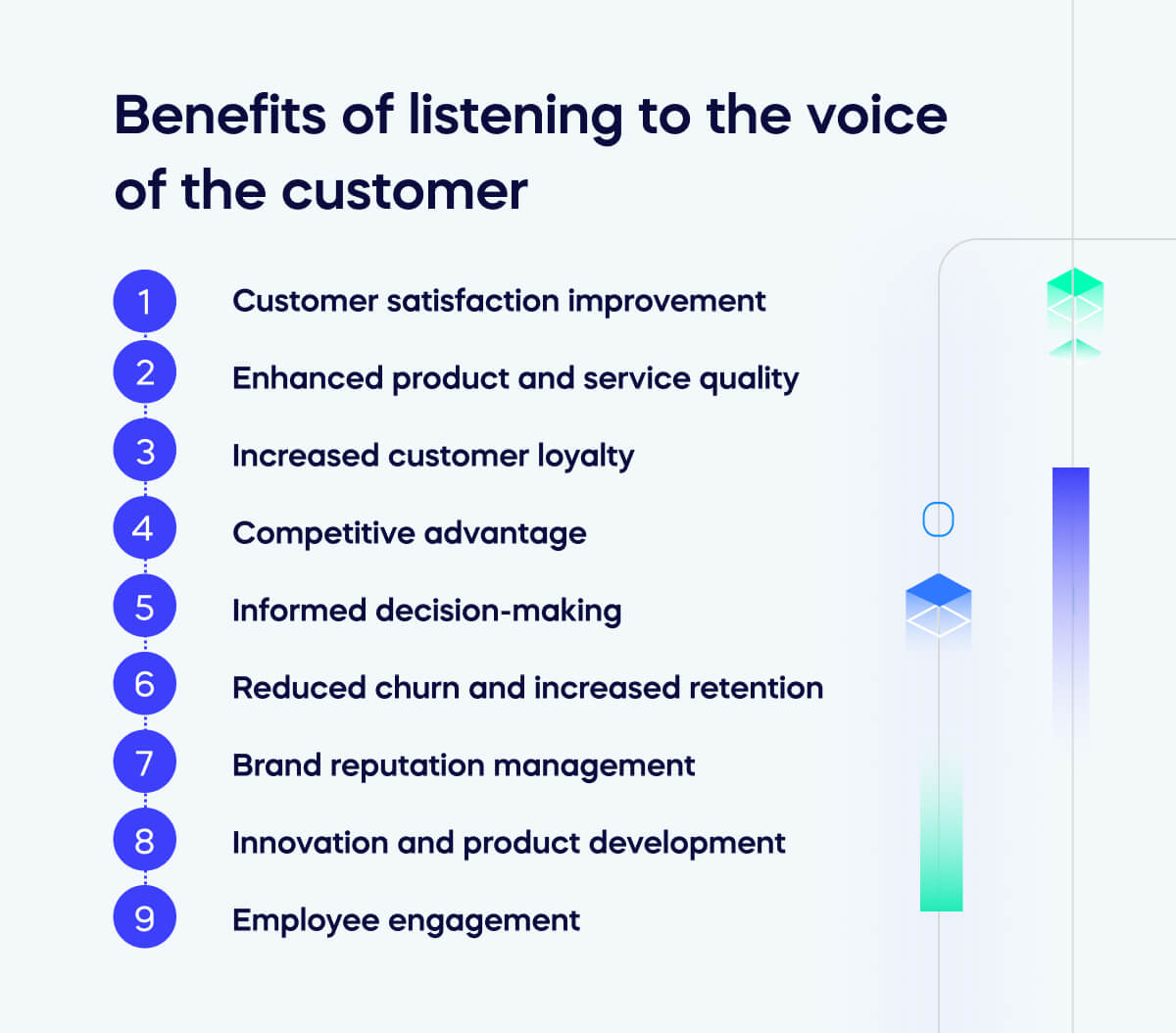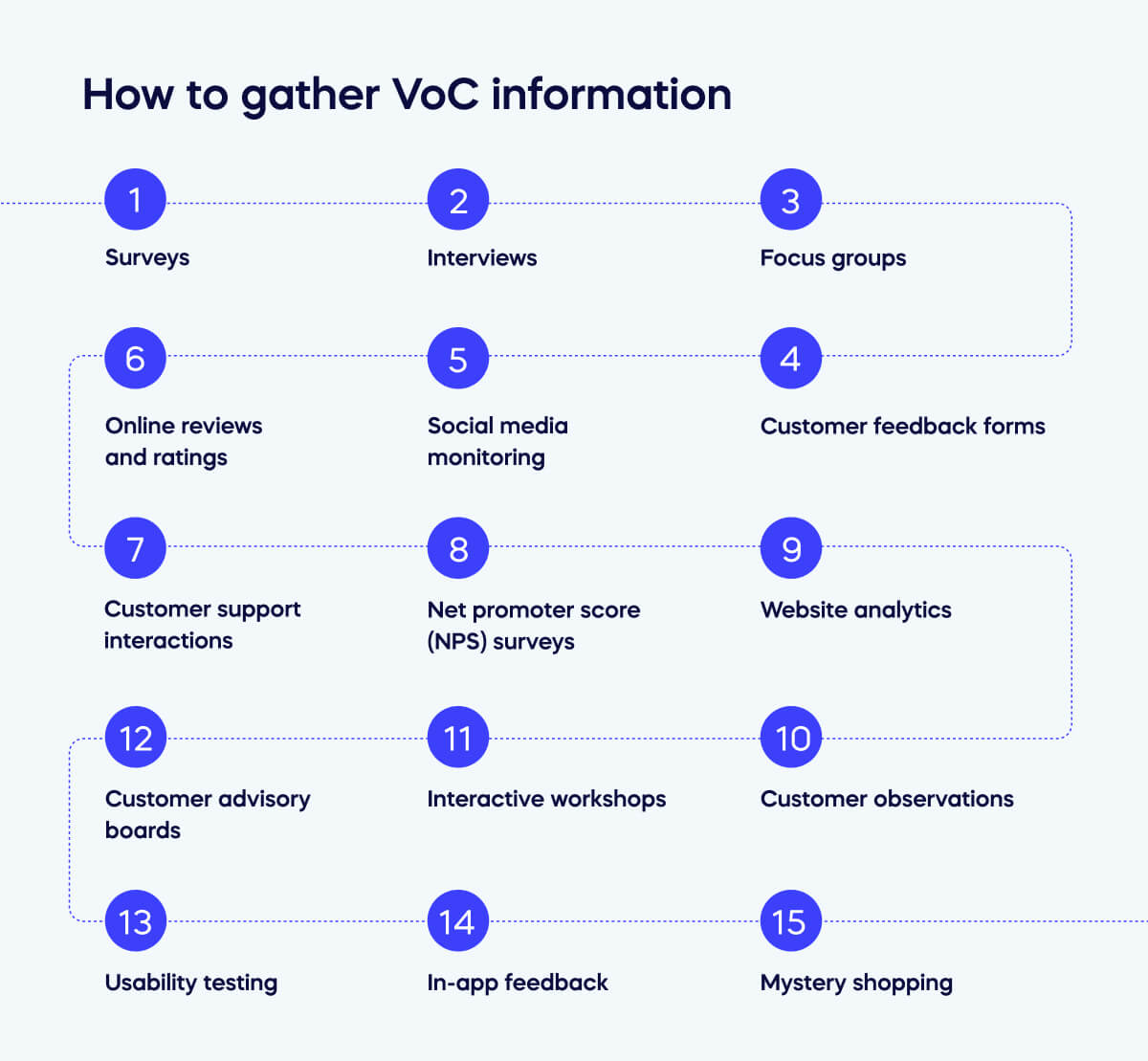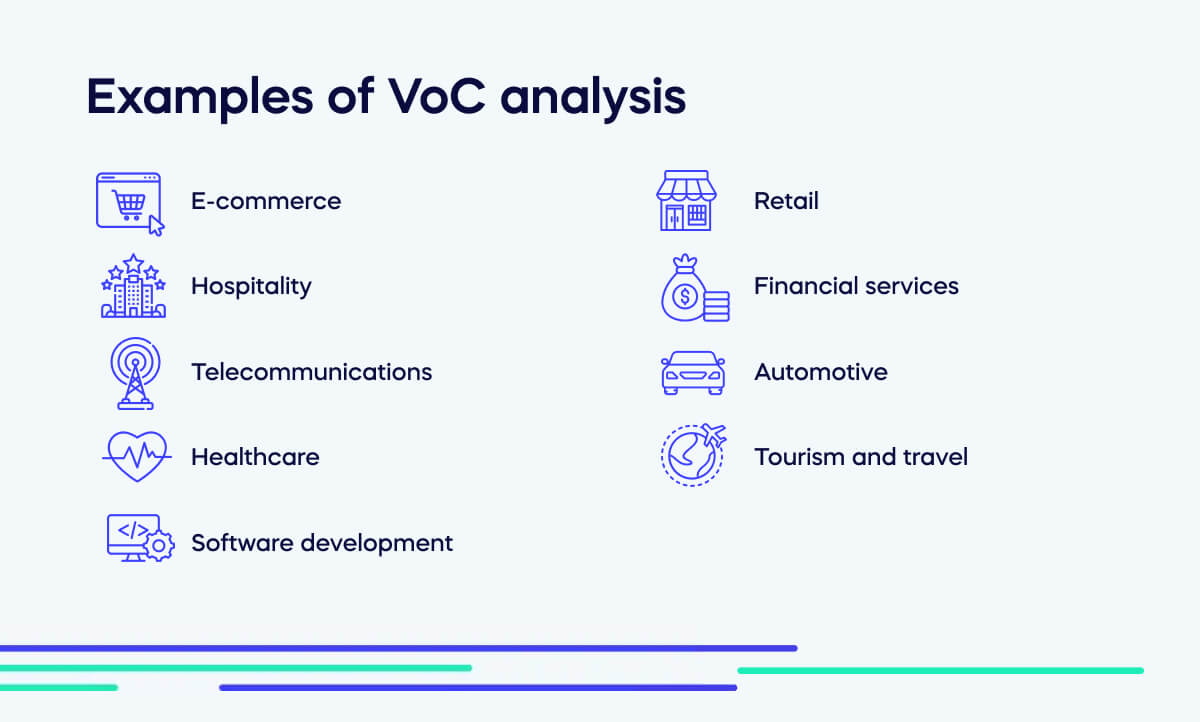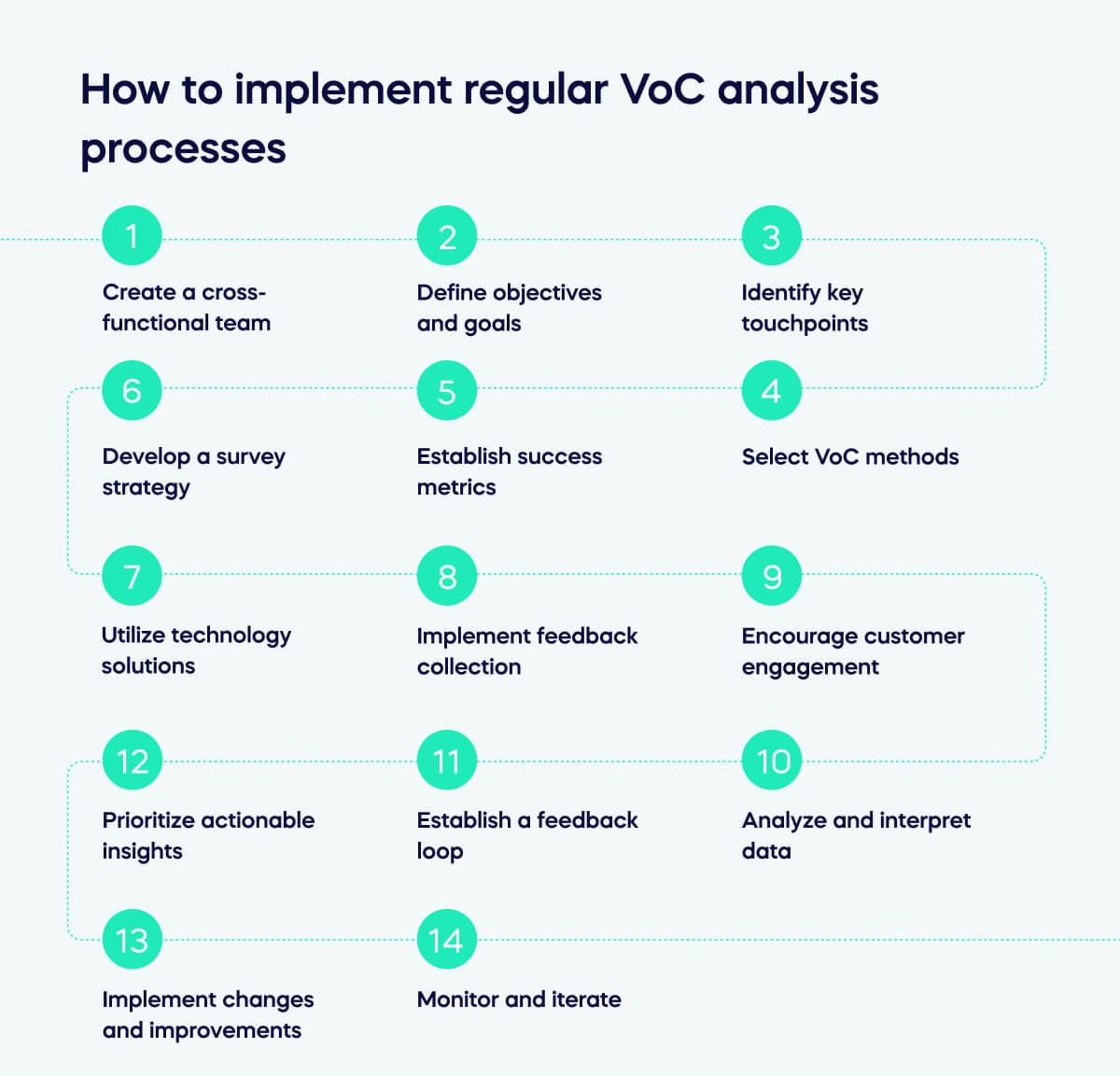What is the voice of the customer (VoC)?
The Voice of the Customer (VoC) is a term that refers to the process of capturing and understanding data relating to what the target user wants or needs.

Research involves gathering information directly from customers to better understand their opinions and perceptions of a brand and their experience with the associated products or services.
VoC programs typically use various methods to collect customer feedback, such as surveys, interviews, focus groups, social media monitoring, and online reviews. The goal is to extract valuable data that can be analyzed to identify trends, patterns, and areas for improvement.
Understanding the voice of the customer equips businesses to make informed decisions, refine their products and services, and ultimately heighten customer satisfaction and foster loyalty.
Implementing a VoC strategy is crucial for businesses looking to stay competitive and customer-focused in today’s market. It helps organizations align their offerings with customer expectations and provides a foundation for continuous improvement.
Benefits of listening to the voice of the customer

The most important aspect of any business is its customers. Without them, a business would not exist. Therefore, companies must listen to the voice of their customers to understand their needs and preferences.
Listening to the voice of the customer has numerous benefits that can ultimately lead to the success and growth of a business.
Some of these benefits include:
Customer satisfaction improvement
By understanding customer needs and preferences, businesses can tailor their products and services to better meet customer expectations, leading to increased satisfaction. Reasons to ramp up customer listening include the fact that companies underestimate the number of poor experiences customers have by an average of 38%, according to Khoros.
Enhanced product and service quality
Customer feedback helps identify areas for improvement, allowing businesses to enhance the quality of their products and services based on real user experiences and preferences.
Increased customer loyalty
When a company makes improvements to products or services directly related to the feedback they have received, they will often experience a rise in loyal customers. This is because people appreciate when their opinions are acknowledged and acted upon. Indeed, ZenDesk reveals that nearly three out of five customers say they will be loyal to a brand if they feel the customer service is good.
Competitive advantage
Companies that actively listen to and respond to customer feedback are often perceived as more customer-centric. This will typically give them a competitive edge as they will attract more users who want to feel they are part of the experience.
Informed decision-making
VoC data provides valuable insights that can guide strategic decision-making. Businesses can prioritize initiatives based on the most important to the customer, rolling out the most effective solutions as informed by their user base.
Reduced churn and increased retention
Understanding the reasons behind customer dissatisfaction can help businesses address issues proactively. In turn, this typically reduces customer churn and increases customer retention rates.
Brand reputation management
Monitoring the VoC allows businesses to address negative feedback promptly, mitigating potential damage to their reputation. Positive customer experiences shared through feedback can also contribute to a positive brand image.
Innovation and product development
By listening to what their customers say, businesses can expand on suggestions to drive innovation and new product development. They can align the desires of their target market with products and services that more effectively meet their needs.
Employee engagement
Sharing positive customer feedback with employees can boost morale and engagement. It helps employees see the direct impact of their efforts on customer satisfaction, fostering a customer-centric culture within the organization.
Impact of not considering VoC
Customer dissatisfaction
When businesses do not fully understand customer needs and preferences, they are more likely to deliver products and services that don’t meet expectations. As a result, they are more likely to experience dissatisfied customers who ultimately stop engaging with the company.
Increased churn
Ignoring customer feedback means missing opportunities to address issues. When unresolved problems accumulate, there is an increased risk of customer churn, as users will often leave for competitors who better meet their needs.
Missed business opportunities
Customer feedback often contains insights into emerging trends, unmet needs, and potential areas for innovation. Failing to consider the VoC may mean missing out on valuable business growth and development opportunities.
Negative brand image
If customers feel their feedback is ignored, it can lead to a negative brand perception. This negative sentiment can spread through word of mouth, online reviews, and social media, damaging the overall brand image.
Loss of competitiveness
In a competitive market, businesses that do not adapt to changing customer preferences and needs risk losing market share to competitors more responsive to customer feedback.
Wasted resources
Without a clear understanding of customer priorities, businesses may allocate resources inefficiently. Investments in areas not aligning with customer expectations may not yield the desired return on investment.
Ineffective decision-making
A lack of customer insights can lead to poor decision-making. Strategic decisions made without considering customer feedback may not resonate with the target audience, resulting in outcomes that do not best meet user needs.
Limited innovation
Customers often provide valuable ideas for innovation and product development. Neglecting the VoC means missing opportunities to create products or services that better address customer needs and differentiate the business in the market.
Reduced employee morale
Employees may become frustrated if they see that customer feedback is consistently ignored. This can lead to decreased morale and engagement, as employees may feel their efforts are not contributing to customer satisfaction.
Difficulty in crisis management
During times of crisis or negative events, a lack of customer feedback and understanding can make it challenging for a business to effectively manage and navigate the situation.
Identifying VoC analysis goals
Establishing clear goals for Voice of the Customer (VoC) analysis is crucial to extracting meaningful insights and driving actionable improvements.
Here are some common goals when conducting VoC analysis:
Customer satisfaction measurement
Assess overall customer satisfaction with products, services, or the entire customer experience. Identify strengths and weaknesses to prioritize improvements effectively.
Understanding customer needs and preferences
Gain insights into what customers value most, their preferences, and the features they prioritize. This information guides product development and service enhancements.
Identifying pain points
Pinpoint specific pain points in the customer journey. Identify areas where customers encounter difficulties or frustrations, leading to dissatisfaction.
Feedback on specific touchpoints
Evaluate customer feedback at specific touchpoints in the customer journey, such as purchasing, onboarding, support interactions, and post-purchase experiences.
Competitor benchmarking
Understand how your business compares to competitors according to your customers. Identify areas where you can differentiate and excel.
Brand perception
Assess how customers perceive your brand. Identify strengths and weaknesses in brand image and reputation to create an action plan.
Product or service improvement
Gather insights to enhance existing products or services. Identify features that need improvement and understand how to meet evolving customer expectations.
Employee performance and training
Evaluate how well employees are delivering on customer expectations. Use feedback to identify training needs and areas for improvement when staff interact with users.
Loyalty and retention
Understand factors influencing customer loyalty. Identify elements that contribute to customer retention and those that may lead to churn. Create plans to improve retention and decrease churn based on this data.
Identification of advocates and detractors
Identify customers who are advocates and actively promote your brand, as well as those who are detractors and may negatively impact your reputation. Tailor strategies to nurture advocates and address detractors.
Operational efficiency
Identify opportunities to streamline processes and improve operational efficiency based on customer feedback. This can lead to cost savings and enhanced experiences for users.
Innovation opportunities
Use customer feedback to build plans for innovation and new product or service development. By addressing unmet needs, a better offering can be provided.
Cross-selling and upselling opportunities
Understand customer preferences and behaviors to identify opportunities for cross-selling or upselling additional products or services.
Communication effectiveness
Evaluate the effectiveness of your communication strategies and messaging. Gather data on how well customers perceive and understand your brand messaging to make improvements where necessary.
How to gather VoC information

When obtaining Voice of the Customer (VoC) information, businesses must collect insights directly from their user base to understand the preferences, experiences, and expectations of those using the products or services.
Here are various methods to gather VoC information:
Surveys
Use online or offline surveys to gather structured feedback. Surveys can cover various topics, from overall satisfaction to specific aspects of products or services.
Interviews
Conduct one-on-one interviews with customers to gain in-depth insights. This method allows for open-ended questions and a deeper understanding of individual experiences.
Focus groups
Assemble small groups of customers to discuss specific topics in a moderated setting. Focus groups allow for group dynamics and the exploration of diverse perspectives.
Customer feedback forms
Implement feedback forms on websites, in-store, or through mobile apps. Provide a convenient way for customers to share their thoughts at various touchpoints.
Social media monitoring
Monitor social media platforms for mentions, comments, and direct messages. Social media is a valuable source for real-time feedback and customer sentiment analysis.
Online reviews and ratings
Analyze reviews on Yelp, Google Reviews, and industry-specific review sites. Aggregate and analyze feedback to identify common themes.
Customer support interactions
Review interactions with customer support, including emails, chat transcripts, and phone calls. Identify recurring issues and gather feedback on the support experience as a whole.
Net promoter score (NPS) surveys
Use NPS surveys to measure customer loyalty and their likelihood of recommending your products or services. This method provides a quantitative measure of customer satisfaction.
Website analytics
Analyze website data to understand customer behavior, navigation patterns, and areas where customers may encounter difficulties.
Customer observations
Observe customer behavior in physical stores or digital platforms. This can provide insights into how customers interact with products and services.
Interactive workshops
Conduct workshops or brainstorming sessions with customers to co-create solutions or explore new ideas collaboratively.
Customer advisory boards
Form a group of key customers who can provide ongoing feedback and strategic insights. Advisory boards foster long-term relationships and in-depth discussions.
Usability testing
Test the usability of products or services with actual users. Gather feedback on the user interface, functionality, and overall user experience.
In-app feedback
For digital products or services, incorporate in-app feedback mechanisms that allow users to provide input directly within the application.
Mystery shopping
Engage mystery shoppers to assess the customer experience anonymously. This method provides an outsider’s perspective on the customer journey, which is particularly effective when gathering data on the best ways to acquire new customers.
Examples of VoC analysis

Here are a few examples of how VoC analysis is implemented in different industries:
E-commerce
Method: Online surveys, customer reviews
Example: An e-commerce company conducts post-purchase surveys to understand customer satisfaction while analyzing product reviews to identify common themes, issues, and positive feedback. This data informs decisions on product improvements, website usability, and customer service enhancements.
Hospitality
Method: Guest feedback forms, online reviews
Example: A hotel uses feedback forms during check-out and monitors online review sites. Insights gathered help the hotel identify areas for improvement, such as room cleanliness, staff responsiveness, and amenities, ultimately enhancing the overall guest experience.
Telecommunications
Method: Customer support interactions, NPS surveys
Example: A telecom company analyzes customer support interactions to identify common issues and areas for improvement. Additionally, NPS surveys are conducted to measure overall customer loyalty and identify promoters and detractors, guiding strategic decisions.
Healthcare
Method: Patient surveys, focus groups
Example: A healthcare provider sends out patient satisfaction surveys after appointments, seeking feedback on wait times, communication with healthcare professionals, and the overall experience. Focus groups might be conducted to delve deeper into patient preferences and suggestions.
Software development
Method: Usability testing, in-app feedback
Example: A software development company conducts usability testing to identify pain points in the user interface and user experience. In-app feedback mechanisms allow users to report bugs, suggest features, and provide general feedback for continuous improvement.
Retail
Method: Mystery shopping, social media monitoring
Example: A retail chain employs mystery shoppers to evaluate store ambiance, customer service, and overall shopping experience. Social media monitoring helps the company stay attuned to customer sentiment and address issues raised by customers on various platforms.
Financial services
Method: Customer interviews, transaction surveys
Example: A bank conducts customer interviews to understand the banking preferences and needs of different customer segments. Transaction surveys are implemented to gather feedback on specific processes, such as loan applications or online banking.
Automotive
Method: Customer advisory boards, dealership feedback forms
Example: An automotive manufacturer establishes a customer advisory board to gather insights on desired features and preferences for future vehicle models. Dealership feedback forms help identify areas for improvement in the sales and service experience.
Tourism and travel
Method: Destination surveys, online reviews
Example: A tourism board collects feedback through destination surveys, understanding visitor satisfaction and areas for improvement in local attractions and services. Online reviews on travel platforms provide insights into the overall tourist experience.
How big brands use the voice of the customer
Here are some examples of how large companies integrate VoC into their strategies:
Apple: Customer feedback and usability testing
Apple actively seeks customer feedback through surveys, product reviews, and direct interactions.
Usability testing is crucial to their product development process, allowing them to refine interfaces and features based on real user experiences.
Amazon: Customer reviews and purchase patterns
Amazon relies heavily on customer reviews to influence purchasing decisions. They analyze this information to understand product strengths and weaknesses.
Additionally, the platform uses data on customer purchase patterns to make personalized product recommendations.
Tesla: Continuous product improvement
Tesla collects data from its electric vehicles to understand how customers use the technology.
Regular over-the-air software updates address issues, introduce new features, and enhance performance based on customer feedback and real-world usage.
Starbucks: Customer feedback surveys and loyalty program
Starbucks gathers customer feedback through surveys and actively engages with its loyalty program members to understand preferences.
This information helps introduce new beverages, refine store layouts, and optimize the overall customer experience.
Google: User feedback and beta testing
Google relies on user feedback to improve its vast range of products.
Beta testing programs allow users to try out new features and provide input, helping Google identify bugs, refine interfaces, and enhance overall user satisfaction.
Microsoft: Customer support insights and user groups
Microsoft collects data from customer support interactions to identify common issues and improve software performance.
They also engage with user groups and communities to gather feedback on software updates and new features.
Coca-Cola: Social media listening and consumer surveys
Coca-Cola monitors social media platforms to understand consumer sentiment and identify emerging trends.
Consumer surveys and taste tests help develop new products and flavors based on customer preferences.
Nike: Direct customer engagement and online communities
Nike engages directly with customers through social media and online communities.
They gather feedback on existing products, solicit design ideas, and involve customers in co-creating new products.
Walmart: Customer feedback forms and data analytics
Walmart uses customer feedback forms to collect insights on store experiences, product availability, and employee interactions.
Data analytics help identify shopping patterns and preferences, informing inventory management and marketing strategies.
Netflix: Viewer ratings and content recommendations
Netflix leverages user ratings and viewing habits to recommend personalized content to its customers.
This data-driven approach enhances the user experience by providing tailored recommendations based on individual preferences.
Facebook: User feedback and feature testing
Facebook regularly solicits user feedback through surveys and uses feature testing to understand how users interact with new functionalities.
This iterative process helps refine the platform based on user preferences and needs.
How are VoC and customer-centricity connected?
Voice of the Customer (VoC) and customer centricity are closely connected concepts, and they both play essential roles in shaping a customer-focused business strategy.
VoC provides the data and insights needed to understand and prioritize customer needs. Customer-centricity is the overarching strategy that incorporates these insights into every aspect of the business.
Together, they create a powerful framework for building strong customer relationships, fostering loyalty, and driving business success.
Here’s how the two work together:
Creating a continuous improvement loop
Customer-centric organizations establish a continuous loop of gathering customer feedback through VoC channels, analyzing this feedback, and implementing changes to enhance the customer experience.
VoC is a feedback mechanism that helps organizations iterate and evolve their customer-centric initiatives.
Giving focus to proactive problem-solving
A customer-centric approach involves proactively identifying and solving customer problems.
VoC allows businesses to identify pain points and challenges directly from the customer’s perspective, enabling them to address issues before they escalate and negatively impact the customer experience.
Informing personalization and customization
Customer-centricity often involves delivering personalized and customized experiences. VoC data helps businesses understand individual customer preferences, allowing them to tailor products, services, and interactions to meet the unique needs of each customer.
Building customer-centric relationships
Both VoC and customer-centricity contribute to building strong and lasting customer relationships.
By actively listening to customers through VoC channels and responding to their needs, businesses demonstrate a commitment to customer satisfaction and loyalty, reinforcing a customer-centric culture.
Guiding internal adjustments
Customer-centric organizations align internal processes, structures, and systems to serve customers better.
VoC insights guide these internal adjustments by highlighting areas hindering a seamless, customer-focused experience.
Measuring strategy success
VoC data is a valuable tool for measuring the success of customer-centric initiatives.
Organizations can gauge the effectiveness of their customer-centric strategies by tracking key metrics such as customer satisfaction scores, Net Promoter Scores (NPS), and customer loyalty.
How to implement regular VoC analysis processes

Implementing regular Voice of the Customer (VoC) analysis processes involves establishing a systematic approach to continuously gather, analyze, and act upon customer feedback.
Here’s a step-by-step guide on how to implement regular VoC analysis processes:
Create a cross-functional team
Form a cross-functional team that includes members from marketing, customer support, product development, and other relevant departments. This team can collaborate to ensure a holistic approach to VoC analysis.
Define objectives and goals
Clearly define the objectives and goals of your VoC program. What specific insights are you seeking? What business areas do you want to improve based on customer feedback?
Identify key touchpoints
Determine the key touchpoints in the customer journey where you will collect feedback. This may include purchase experiences, customer support interactions, product usage, etc.
Select VoC methods
Choose the appropriate VoC methods for gathering feedback based on your objectives and touchpoints. This could include surveys, interviews, feedback forms, social media monitoring, online reviews, and other channels.
Establish success metrics
Decide on key performance indicators (KPIs) to measure the success of your VoC program. Track metrics such as customer satisfaction scores, Net Promoter Scores (NPS), and other relevant indicators.
Develop a survey strategy
If surveys are part of your VoC strategy, design surveys that are clear, concise, and focused on gathering actionable insights. Consider both quantitative and qualitative questions to capture a range of feedback.
Utilize technology solutions
Explore and implement technology solutions to streamline the feedback collection and analysis process. Various VoC platforms and tools can help automate survey distribution, collect data, and generate insights.
Implement feedback collection
Deploy your chosen VoC methods to collect feedback regularly. Implement surveys, feedback forms, and other mechanisms at specified touchpoints. Ensure that feedback collection is ongoing and not limited to one-time campaigns.
Encourage customer engagement
Foster a culture of customer engagement by encouraging customers to provide feedback and participate in surveys. Acknowledge their contributions and let them know they are contributing to creating a better customer experience.
Analyze and interpret data
Regularly analyze and interpret the collected data. Look for patterns, trends, and areas for improvement. Quantitative data can provide numerical insights, while qualitative data from open-ended questions can offer deeper context.
Establish a feedback loop
Create a structured feedback loop to ensure insights are shared across the organization. Regularly communicate findings to relevant teams and stakeholders, fostering a culture of continuous improvement.
Prioritize actionable insights
Prioritize actionable insights that have the potential to drive meaningful improvements. Focus on addressing issues that align with your business objectives and will positively impact customer satisfaction.
Implement changes and improvements
Act on the insights gathered from VoC analysis. Implement changes and improvements based on customer feedback. Communicate changes to customers when appropriate and show them that their feedback is valued.
Monitor and iterate
Continuously monitor the impact of changes and iterate as needed. Regularly revisit your VoC strategy to align with evolving business goals and customer expectations.